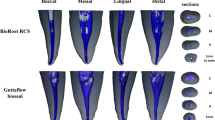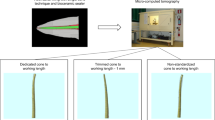Abstract
Objectives
The aim of the study was to measure the percentage of volume of voids and gaps in the apical third of root canals obturated with two techniques using micro-computed tomography.
Materials and methods
Fifty-four single-rooted teeth were collected and root canal-prepared. The roots were randomly allocated into two groups; each group was obturated by using thermoplasticized technique with a different material (gutta-percha and Topseal for Thermafil, Resilon and RealSeal for RealSeal 1). Roots were then scanned, and volume measurements for voids and gaps in the obturated roots were carried out using specialized CT software. Percentage of gaps and voids was calculated.
Results
The present study showed that none of the root canal-filled teeth was gap free. Student t test was conducted. No significant difference was found between Thermafil and RealSeal 1 concerning percentage of voids in the apical third (P > 0.05). Both materials showed statistically significant difference between the levels where 1 mm showed the highest volume of voids (P < 0.05).
Conclusions
Both carrier-based techniques allowed a good sealing ability in root canals but none of the materials was gap free. Statistically significant difference between the levels was found and 1 mm showed the highest volume of voids.
Clinical relevance
This study shows the efficiency of carrier-based obturation systems in filling root canals hermetically. It compares new adhesive endodontic materials with the traditional gold standard gutta-percha. Results show the good sealing ability of both techniques making them appropriate to use in daily endodontic obturations.


Similar content being viewed by others
References
Huybrechts B, Bud M, Bergmans L, Lambrechts P, Jacobs R (2009) Void detection in root fillings using intraoral analogue, intraoral digital and cone beam CT images. Int Endod J 42:675–685
Hammad M, Qualtrough A, Silikas N (2009) Evaluation of root canal obturation: a three dimensional in vitro study. J Endod 35:541–544
Schilder H (1967) Filling root canals in three dimensions. Dent Clin N Am 11:723–744
DuLac K, Nielsen C, Tomazic T, Ferrillo P, Hatton J (1999) Comparison of the obturation of lateral canals by six techniques. J Endod 5:376–380
Weller RN et al (1997) A comparison of thermoplastic obturation techniques: adaptation to the canal walls. J Endod 23:703–706
Becker TA et al (1997) Thermafil obturation: a literature review. Gen Dent 45:46–55
Sutow E, Foong W, Zakariasen K, Hall G, Jones D (1999) Corrosion and cytotoxicity evaluation of Thermafil endodontic obturator carriers. J Endod 8:562–566
Marlin J, Schilder H (1973) Physical properties of gutta-percha when subjected to heat and condensation. Oral Surg Oral Med Oral Pathol 36:872
Marciano J, Michailesco PM (1989) Dental gutta-percha chemical composition, X-ray identification, enthalpic studies and clinical applications. J Endod 11:149–153
Shipper G, Teixeira FB, Trope M (2004) An evaluation of microbial leakage in roots filled with a thermoplastic synthetic polymer-based root canal filling material (Resilon). J Endod 30:342–347
Teixeira FB, Arnold R, Trope M (2005) Periapical inflammation after coronal microbial inoculation of dog roots filled with gutta-percha or Resilon. J Endod 31:91–96
Tay FR, Hiraishi N, Pashley DH, Loushine RJ, Weller N, Gillespie WT, Doyle MD (2006) Bondability of resilon to a methacrylate-based root canal sealer. J Endod 32:133–137
Kqiku L, Stadtler P, Gruber HJ, Baraba A, Anic I, Miletic I (2011) Active versus passive microleakage of Resilon/Epiphany and gutta-percha/AH Plus. Aust Endod J 37(3):141–146
Jung M, Lommel D, Klimek J (2005) The imaging of root canal obturation using micro-CT. Int Endod J 38:617–626
Dowker SE, Davis GR, Elliott JC (1997) X-ray microtomography: nondestructive threedimensional imaging for in vitro endodontic studies. Oral Surg Oral Med Oral Pathol Oral Radiol Endod 83:510–516
Swain MV, Xue J (2009) State of the art of micro-CT applications in dental research. Int J Oral Sc 1:177–188
Farea M, Masudi S, Wan Bakar WZ (2010) Apical microleakage evaluation of system B compared with cold lateral technique: in vitro study. Aust Endod J 36:48–53
Whitworth J (2005) Methods of filling root canals: principles and practice. Endod Top 12:2–24
Lares C, Eldeeb M (1990) The sealing ability of the Thermafil obturation technique. J Endod 16:474–479
De-Deus G, Brandao MC, Fidel RA, Fidel SR (2007) The sealing ability of GuttaFlow in ovalshaped canals: an ex vivo study using a polymicrobial leakage model. Int Endod J 40:794–799
Wu M-K, van der Sluis LWM, Wesselink PR (2002) A preliminary study of the percentage of the gutta-percha-filled area in the apical canal filled with vertically compacted warm gutta-percha. Int Endod J 35:527–535
Goldberg F, Artaza LP, De Silvio A (2001) Effectiveness of different obturation techniques in the filling of simulated lateral canals. J Endod 27:362–364
Epley S, Fleischman J, Hartwell G, Cicalese C (2006) Completeness of root canal obturations: epiphany techniques versus gutta-percha techniques. J Endod 32:541–555
Gulsahi K, Cehreli ZC, Onay EO, Tasman-Dagli F, Ungor M (2007) Comparison of the area of resin-based sealer and voids in roots obturated with Resilon and gutta-percha. J Endod 33:1338–1341
Elayouti A, Achleithner C, Lost C, Weiger R (2005) Homogeneity and adaptation of a new gutta-percha paste to root canal walls. J Endod 31:687–690
James BL, Brown CE, Legan JJ, Moore BK, Vail MM (2007) An in vitro evaluation of the contents of root canals obturated with gutta percha and AH-26 sealer or Resilon and Epiphany sealer. J Endod 33:1359–1363
Nielsen RB, Alyassin AM, Peters DD et al (1995) Microcomputed tomography: an advanced system for detailed endodontic research. J Endod 21:561–568
Hammad M, Qualtrough A, Silikas N (2008) Three-dimensional evaluation of effectiveness of hand and rotary instrumentation for retreatment of canals filled with different materials. J Endod 34:1370–1373
Barletta FB, Rahde Nde M, Limongi O, Moura AA, Zanesco C, Mazocatto G (2007) In vitro comparative analysis of 2 mechanical techniques for removing gutta-percha during retreatment. J Can Dent Assoc 73:65
Endal U, Shen Y, Knut A, Gao Y, Haapasalo M (2011) A high-resolution computed tomographic study of changes in root canal isthmus area by instrumentation and root filling. J Endod 37:223–227
Zogheib C, Naaman A, Medioni E, Arbab-Chirani R (2012) Influence of apical taper on the quality of thermoplasticized root fillings assessed by micro-computed tomography. Clin Oral Investig 16(5):1493–1498
Zaslansky P, Fratzl P, Rack A, Wu MK, Wesselink PR, Shemesh H (2011) Identification of root filling interfaces by microscopy and tomography methods. Int Endod J 44(5):395–401
Somma F, Cretella G, Carotenuto M et al (2011) Quality of thermoplasticized and single point root fillings assessed by micro-computed tomography. Int Endod J 44(4):362–369
Acknowledgments
This study was supported by a grant from the Saint Joseph University, Beirut, Lebanon. The authors wish to thank Sybron Endo Europe and Dentsply, Maillefer, Switzerland for providing the tested materials.
Conflicts of interest
The authors declare that they have no conflict of interest or any financial relationship with the organizations that sponsored the research.
Author information
Authors and Affiliations
Corresponding author
Electronic supplementary material
Below is the link to the electronic supplementary material.
(AVI 12626 kb)
Rights and permissions
About this article
Cite this article
Zogheib, C., Naaman, A., Sigurdsson, A. et al. Comparative micro-computed tomographic evaluation of two carrier-based obturation systems. Clin Oral Invest 17, 1879–1883 (2013). https://doi.org/10.1007/s00784-012-0875-1
Received:
Accepted:
Published:
Issue Date:
DOI: https://doi.org/10.1007/s00784-012-0875-1




